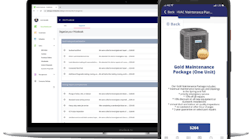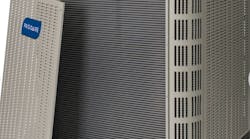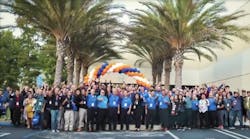Introduction
The wholesale distribution of HVACR control products for plan-and-spec projects is sprouting into areas previously avoided. Airflow measurement devices are one of these areas and are fundamental to optimum control of ventilation rates and pressurization flow. Designers and suppliers should understand why, where and how to specify these products to ensure the operating performance required for success in their respective project roles.
Although these are primarily engineered products, rarely the same size and beyond the operational capabilities or strategic interest of most wholesalers, a few have found compensation for the differences needed to be successful, beyond a competitive price and immediate availability. Hopefully this article provides enough information to allow the reader to differentiate the performance requirements needed for these applications from those more commodity-oriented technologies you are more familiar with.
Background
Successful application of airflow instrumentation is easier now with improved technology, which in some instances has been a direct result of the increasing power and decreasing cost of microprocessors. Speed, reliability, repeatability and network communications apply equally to the capabilities of microprocessors as they do to the desired traits of measurement instruments.
When combined with effective control sequences, this control hardware can become a dynamic air control strategy. Correct implementation of a dynamic strategy can offer:
· Reliable control of contaminants and air exchange rates under all operating conditions.
· First-cost savings from more efficient equipment selections and sizing: motors, drives, fans, coils, etc.
· Verify compliance and supply only the minimum amount of outdoor air required satisfying Standards and Codes, while maintaining reliable and low energy cost. control of space pressurization flow. Efficiency is more meaningful with conditioning costs for energy at approximately $1 to $5 / CFM and rising.
· Some airflow control strategies can provide 20% - 30% fan energy savings during normal operation compared to traditional strategies.
· More consistent comfort control.
Codes and Standards
A significant majority of our national standards and codes require outdoor air intake and recommend additionally supply air volumetric measurement. These two key HVACR data points are critical to energy performance monitoring and maximizing efficiency when complying with dilution ventilation requirements. Adding return/relief air data input has multiple benefits, allowing more precise and effective control of space pressurization flow, but also to allow DDC systems to minimize the fan energy required for effective control.
ASHRAE has become more vocal in expressing minimum requirements for airflow measurement in codified standards development, namely: Standards 62.1, 90.1 and 189.1P. The International Mechanical Code’s Chapter 4 on Ventilation also effectively requires outdoor air measurement for all VAV systems. The LEED Rating System requirements strongly influenced 189.1P Standard for the Design of High Performance Green Buildings, which is written in code-language for its anticipated adoption by local code authorities.
Both documents require Outdoor Air Delivery Monitoring, for all lower-density and combined density occupancies provided with mechanical ventilation systems. Usage in HVACR control for energy minimization is an option. Compliance with 62.1 and 90.1 are prerequisites for LEED certification, reinforcing the need for improved sensors and their expanded use.
So, how can bidders know what will be necessary to provide?
Performance Specifications
The intent of a performance specification is to provide the project with the required minimum performance and features required by the design and code minimums. A performance specification satisfies the non-proprietary spec requirement of most governmental agencies. When you can document the measurement performance stated and verified by the prospective vendor, then the nature of the technology, product construction details or materials used, etc. become irrelevant. The only concern of the design engineer is verifying that the bidder can provide the performance that they claim. For these reasons, we should examine some of the items that are critical for the performance specification for airflow measurement, under today’s minimum requirements. Below are items to note before making a selection.
We will focus on the outdoor air application, as it is the most readily recognized minimum requirement and one of the most difficult conditions under which to operate successfully. This level of performance should also guide the specification criteria for other applications, because repeatability of these devices is keenly important to operational reliability, especially when many applications prevent them from being accurate in the absolute. Commonality also lends itself to installation error avoidance, maintenance simplicity, installation economies and parts.
Because of the nature of Variable Air Volume (VAV) systems and the minimum requirements outlined earlier, we will assume that the measurement equipment must perform within those minimums (accuracy, turndown, repeatability, operating range, etc.). These are some of the qualities that differentiate measurement technologies, among a number of others. Therefore, we must focus on thermal dispersion instruments only, as other technologies cannot meet the low flow, measurement range and precision or placement requirements. Traditional pressure-based products are clearly not appropriate for this application and are not allowed in this example. The performance variables we need for this project and other useful features are included below, in MasterFormat structure.
| 23 09 13.23 Sensors and Transmitters | Author’s Comment / Explanation | |
| PART 1 GENERAL | ||
| 1.1 RELATED DOCUMENTS | ||
| 1.2 SUMMARY | ||
| 1.3 REFERENCES | ||
| A. UL 873 – Temperature (and Airflow) Indicating Equipment | The only UL test standard specifically for AMD systems. | |
| 1.4 SUBMITTALS | ||
| A. Submit product data sheets for airflow measuring devices indicating minimum placement requirements, sensor density, sensor distribution, and installed accuracy to the host control system. | Critical information and documents to review for spec compliance. | |
| B. Submit installation, operation and maintenance documentation. | Allows engineer to identify any questionable requirements or limitations prior to installation. | |
| 1.5 SEQUENCE(S) OF OPERATION | (Insert sequence description or its alternate location.) | |
| 1.6 QUALIFICATIONS AND QUALITY ASSURANCE | ||
| A. Manufacturer Qualifications: The successful firm shall have a minimum of ten years experience producing microprocessor-based, multi-point thermal dispersion velocity meters and shall have a record of successful in-service performance verified by the consulting mechanical engineer. | The lengths of experience and service history are important to provide the designer a reasonable expectation that production equipment can perform without significant problems. The product description is typical of that offered by several manufacturers. | |
| B. Installer Qualifications | The installer’s qualifications and experience are also important, but it should be the specifier’s responsibility to decide how restrictive to make them. | |
| C. Instruments, Devices, and Accessories: Products described in this Section shall be Listed and labeled in accordance with the UL Listing and Follow-up Service having been tested in accordance with standard UL 873 – Temperature (and Airflow) Indicating Equipment as a complete and functional assembly by a testing agency acceptable to authorities having jurisdiction. | A UL Listing is much different from a rating. Listing signifies that the manufacturer subscribes to the UL Follow-up service that inspects production parts, facility and processes to insure that current product is equal to that originally tested and approved. | |
| 1.7 SYSTEM RESPONSIBILITY | ||
| A. The contractor shall be responsible for all costs associated with any changes resulting from the use of a supplier other than the listed acceptable manufacturer(s).. | This assures that the performances of substitutes are the responsibility of the supplier. It creates a barrier for the supplier should they attempt to attribute poor performance to those who “approved” their submission. | |
| 1.8 WARRANTY | A 36-month limited warranty is typically available by the leading suppliers. | |
| 1.9 DELIVERY, STORAGE, AND HANDLING | Best to follow the manufacturer’s recommendations here. | |
| PART 2 PRODUCTS | ||
| 2.1 PRODUCTS INCLUDED IN THIS SECTION | ||
| A. Duct and plenum mounted airflow and temperature measurement devices | Most thermal dispersion products also provide temperature which is needed for velocity determination. | |
| 2.2 ACCEPTABLE MANUFACTURERS | ||
| A. Subject to compliance with performance and design requirements of this Section, provide products that comply with this specification by one of the following vendors: | Limit named vendors to only those the engineer knows can comply with the performance required; otherwise naming a lesser brand devalues the design. | |
| 1. xxxxxx (basis of design) | ||
| 2. Alternatives requesting acceptance as “equals” less than 60 days prior to bid date or products submitted in non-conformance with the requirements of this specification will not be considered. | A deadline for those requesting consideration as alternates is appropriate to allow the engineer time to research the ability of the product to comply with the spec requirements. | |
| a) Any firm submitting a product as an equal shall make available a functioning non-fan powered demonstration sample for review in the specifying engineer’s office. | Should a manufacturer be unable or unwilling to provide a functioning sample for examination by the designer, there is good reason to suspect that the product is not capable of providing the sensitivity at low flows required by this spec.. | |
| 2.3 AIRFLOW MEASUREMENT DEVICES | ||
| A. Provide airflow and temperature measurement devices where indicated on the plans. | ||
| B. Each AMD shall consist of one or more sensor probes and a single, remotely mounted, microprocessor-based transmitter capable of independently processing all sensor nodes contained in one or more probe assemblies per measurement location. | Generic description of arrayed probes with independent sensors. | |
| 1. The airflow rate at each sensor node shall be determined, equally weighted and arithmetically averaged by the transmitter prior to output. All integrated circuitry shall be temperature rated as ‘industrial-grade’. Submissions containing ‘commercial-grade’ integrated circuitry are not acceptable. | To provide the performance required under various placement conditions, independence of the sensors is mandatory. Temperature variations shorten the life expectancy of electronic components. Industrial ratings are necessary for integrated circuits to survive in unconditioned spaces. | |
| 2. The temperature at each sensor node shall be arithmetically averaged, or velocity weighted and averaged by the transmitter prior to output, either field-selected by the contractor or user. | Average temperature is generally available from thermal dispersion instruments. | |
| 3. Each transmitter shall have a alpha-numeric display capable of displaying airflow, temperature, system status, configuration settings and diagnostics. | Good feature, either standard or available from all sources. Most require it as visual interface any internal diagnostic or setup software. | |
| 4. Devices using chip-in-glass, epoxy-coated or diode-case chip thermistors are not acceptable. | These types of thermistors are not designed for repeated heat/cool cycling and to be used for outdoor airflow measurement. | |
| 5. Devices with RJ-45 connections exposed to the environment or having electronic circuitry mounted in or at the sensor node are not acceptable. | These items are susceptible to corrosion and failure from exposure to extreme temperatures and liquid water. | |
| 6. Pitot arrays and all pressure-based measurement products are not acceptable. | Based on the velocity operating range recommended in the 2009 ASHRAE Fundamentals Handbook Chapter 36.16, neither are recommended for operating near maximum turndown (150-400 fpm) for this application. | |
| 7. Vortex shedding devices are not acceptable. | ||
| C. Sensors | ||
| 1. Each sensor node, shall independently determine the airflow rate (and temperature) at each measurement point. | See B.1 | |
| 2. Each sensor node shall be factory calibrated at a minimum of 16 airflow rates and 3 temperatures to standards that are traceable to the National Institute of Standards and Technology (NIST). | Some manufacturers do not factory calibrate and most do not calibrate to this extent for a more predictable output curve. Although the designer may accept an exception, changing this minimum will not allow them to identify which products can provide this level of reliability. | |
| a) Temperature sensor calibrations traceable only to temperature standards are not acceptable. | This item avoids misrepresentation by some suppliers. | |
| b) Sensors, leads, connections and wiring shall be sufficiently protected from exposure to the airstream to avoid corrosion and failure. | The effect from humidity is different from that of water emersion, particularly if a design exposes wiring, electronics or processors to the measured airstream. Minimally exposed thermal sensors can quickly dry and return to normal operation, whereas, IC’s exposed will likely fail. | |
| 3. Factory certified airflow accuracy for each sensor node shall be +/-2% of Reading or less over the entire operating airflow range of not less than 0 to 5,000 fpm (25.4 m/s). This overall accuracy statement includes non-linearity, temperature effect, zero drift and all components of operational precision and shall be accompanied by a factory calibration certificate,. | Both the accuracy statement and the range of operation for that accuracy are key to a valid comparative analysis. A shorter range can justify an average supporting greater precision. This accuracy statement without the context of range, configuration, calibration and other properties is not very useful. | |
| a) Repeatability shall be .0.25% of reading or greater | Repeatability is the key to reliability and accuracy. | |
| b) Installed system accuracy shall be +/-3% of Reading or less over the entire operating airflow range of not less than 0 to 5,000 fpm (25.4 m/s). | This requirement relates to the density of sensors required to provide this level of performance for specific placement limitations outlined by the manufacturer. | |
| 4. Once installed, AMDs shall not require periodic recalibration or maintenance when placed in accordance with the manufacturer’s guidelines and instructions. | Performance achieved during one test, when new or under ideal conditions are no indications of a product’s ability to function as required during operation. Maintenance and regular calibration requirements are a deterrent to a favorable long term outcome. | |
| 5. Temperature accuracy shall be +/-0.14° F (0.08° C) over the entire operating temperature range of -20° F to 160° F (-28.9° C to 71° C). | The CEC/LBNL guide for performance monitoring indicates outdoor air temperature measurement minimum performance of 0.2° F is required. | |
| 6. The operating humidity range for each sensor probe shall be 0-99% RH (non-condensing). Product design shall consider direct exposure to or emersion in liquid water and temporary exposure shall not damage the exposed electronics or sensing elements. | The effect from humidity is different from that of water emersion, particularly if a design exposes electronics or processors to the measured airstream. Minimally exposed sensors can quickly dry and return to normal operation, whereas, IC’s exposed will likely corrode and fail. | |
| D. Duct and Plenum Probes | ||
| 1. The number of individual sensor nodes provided for each (rectangular) location shall be as follows: | Relates to installed measurement performance capability. | |
| Duct or Plenum Area (ft2) | Total # Nodes / Location | Specify number of sensors and distribution of nodes per duct face area. Without sensor density requirement, single sensor devices can comply yet not produce a comparable duct average |
| <= 1 | 1 or 2 | |
| >1 to <4 | 4 | |
| 4 to < 8 | 6 | |
| 8 to < 12 | 8 | |
| 12 to <16 | 12 | |
| >=16 | 16 | |
| 4. The operating temperature range for the transmitter shall be -20° F to 120° F (-28.9° C to 48.9° C). The transmitter shall be installed at a location that is protected from weather and water. | Expected environmental conditions or operating range allowed should be specified for designs to be comparable. | |
| 5. The transmitter shall be capable of communicating with other devices using one of the following interface options: | Self-explanatory. | |
| a) Linear analog output signals for airflow and temperature: Field selectable, fuse protected and electrically isolated from all other circuitry, 0-5VDC / 0-10VDC / 4-20mA (4-wire) | Traditional method of sensor communications. | |
| b) Analog output resolution shall be 0.025% of full scale or better. | Minimizing output resolution problems limits potential increased uncertainties when converting back to digital form in final determinations by the host controller. | |
| c) RS-485: Field selectable BACnet-MS/TP, BACnet-ARCNET, Modbus-RTU or Johnson Controls N2-Bus | Distributed network sensors communicate directly with the host controller’s processor without conversion from analog-digital and suffering from limited resolution of the output. Analog signals are also subject to noise and electronic interference. Digital communication protocols include error correcting features and avoid most electronic noise problems. They also provide more information on a twisted-pair than can be provided on four wires. | |
| i. BACnet devices shall provide analog variables for airflow and temperature containing individual sensor airflow rate and temperature data. | ||
| d) 10 Base-T Ethernet: Field selectable BACnet Ethernet, BACnet-IP, Modbus-TCP and TCP/IP | ||
| e) LonWorks Free Topology | ||
| 7. The transmitter shall be capable of identifying a ‘damaged’ sensor node, ignore it, notify the user and continue to operate by correctly averaging the remaining sensor nodes. | Software feature of one manufacturer, but other processor-based transmitters should be capable of supplying. | |
| G. The AMD shall carry the CE Mark for European Union shipments, certifying compliance with all applicable compliance testing, regulations and EU directives. | This may be an important requirement for some users and provides an extra layer of quality assurance for all users. | |
| H. The manufacturer’s authorized representative shall review and approve intended / actual placement and operating airflow rates for each measurement location indicated on the plans. | The availability of local support, design, placement and follow up assistance should be important for a supplier’s selection. | |
| 1. A written report shall be submitted to the consulting mechanical engineer if any measurement locations do not meet the manufacturer’s placement conditions or requirements. | ||
Conclusion
Although this article is not an attempt to encourage wholesalers from operating their businesses in contradiction to strategic objectives, the outdoor air application and general contrast drawn between the products required here and more traditional airflow measurement devices is worth attention.
Regardless of the level of detail included in specifications, one change can negate the effort by the engineer or owner to insure that desired products were supplied. Regardless of the length or specificity, the engineer must learn the differences between alternative products and which are appropriate for their design – then reject any submission that is not in compliance. It is only in this way that the integrity of the design is protected and performance can be assured.
Leonard A. Damiano is Vice President - Marketing and International Sales for EBTRON, Inc. EBTRON, Inc. manufactures microprocessor-based air velocity and temperature meters for HVAC monitoring and control. Acknowledged as the technological leader in their industry, EBTRON is a pioneer in products for the HVAC applications of thermal dispersion technology (1984), direct outdoor airflow measurement (1989) and distributed network sensors (1992). Contact him (800) 232-8766 or [email protected].







